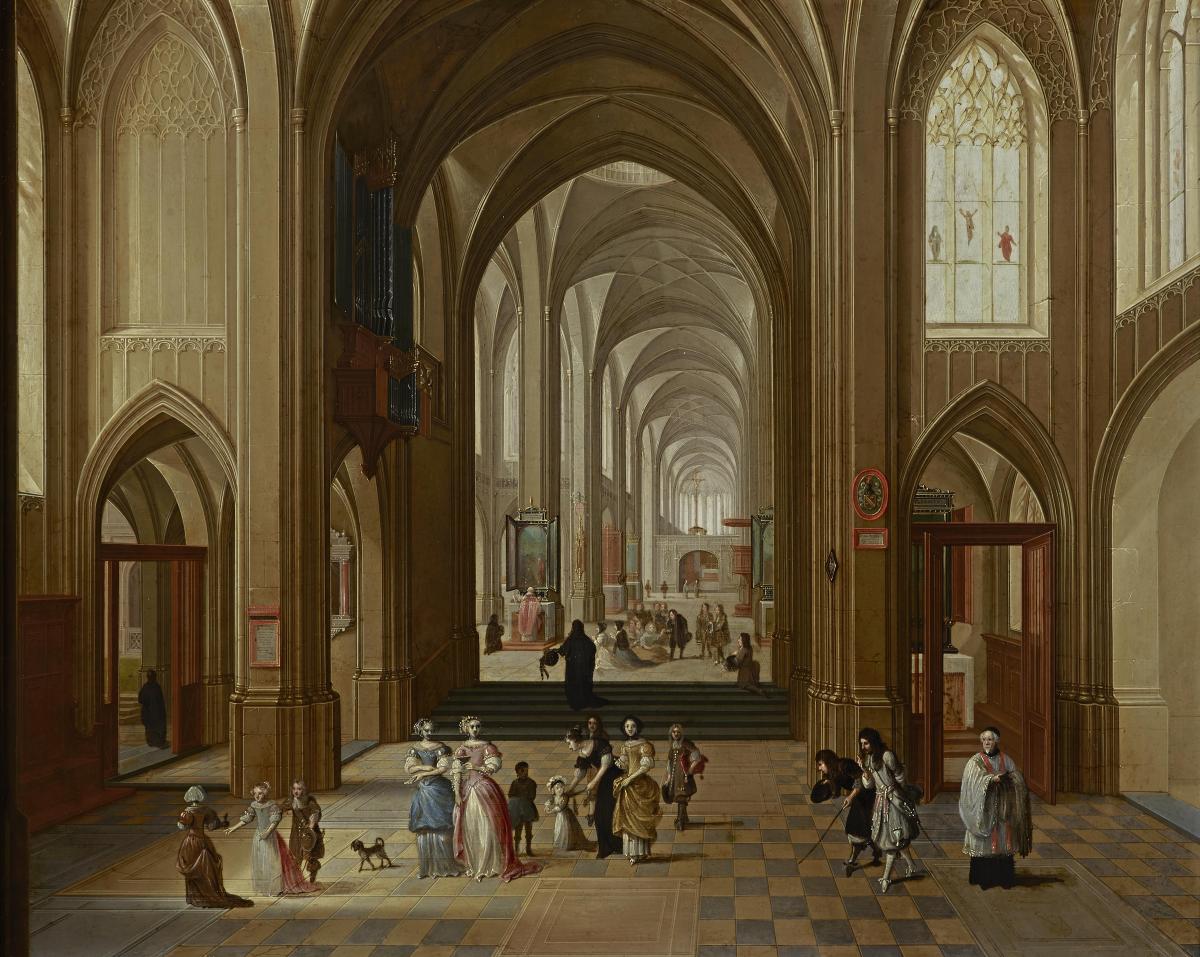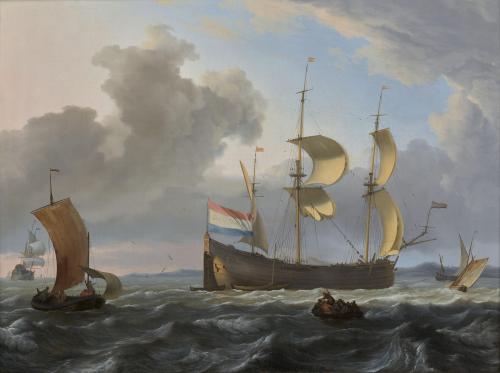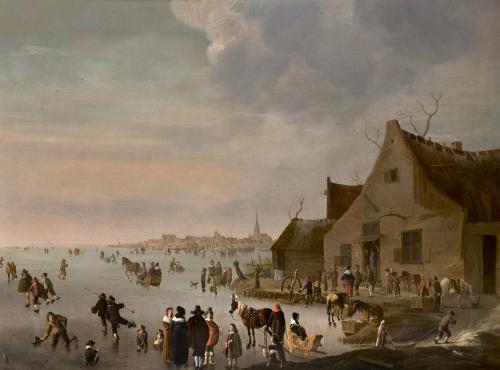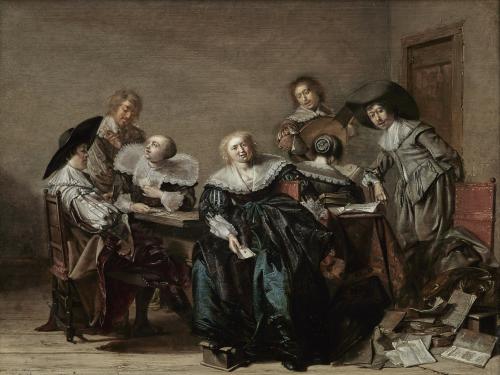

This object is eligible for a Certificate of BADA Provenance
The BADA Standard
- Since 1918, BADA has been the leading association for the antiques and fine art trade
- Members are elected for their knowledge, integrity and quality of stock
- Our clients are protected by BADA’s code of conduct
- Our dealers’ membership is reviewed and renewed annually
- Bada.org is a non-profit site: clients deal directly with members and they pay no hidden fees
PIETER NEEFS the Elder
(c. 1578 – Antwerp – 1656)
The Interior of Antwerp Cathedral with elegant Figures
Oil on copper, 14⅛ x 17¾ ins. (36 x 45.2 cm)
PROVENANCE
Private collection, Portugal, before 1981
By descent to the previous owner
Private collection, Portugal, until 2019
NOTE
With staffage added later by another hand, probably Hieronymus Janssens (1624-1693).
A lifelong resident of Antwerp, Pieter Neefs the Elder specialised in painting church interiors. He became a master in the Antwerp Guild of St. Luke in 1609-10. Neefs followed the style of the architectural painters Hendrick van Steenwyck the Elder (c. 1550 – 1603) and his son Hendrick van Steenwyck the Younger (c. 1580-1629), with whom he is thought to have studied. His own son and pupil Pieter Neefs the Younger (1620-1675) perpetuated his speciality in a very similar style.
An example of the artist’s most popular composition, the interior depicted here is based on that of the Cathedral of Our Lady (Onze Lieve Vrouwekerk), in Antwerp. Neefs made many versions of the subject, with variations in the angle of the view, the time of the day, and the interior furnishings, which are often fanciful. Although not strictly accurate as representations of the Cathedral, they nonetheless convey an impression of its interior as it appeared in the seventeenth century, after the new altarpieces and monuments had been installed to replace those destroyed by the iconoclasm of the previous century. There was clearly a strong demand for such views among members of Antwerp’s rich Catholic community, as well as from visitors to the city who wished to have a souvenir of the recently restored cathedral.
In this painting, Neefs has taken a view from a slightly elevated vantage point, looking down the length of the nave towards the distant high altar, visible through an arch in the rood screen. The lofty, vaulted structure is flooded with daylight, illuminating with great clarity the intricate beauty of the Gothic architecture and the retreating rows of Baroque altarpieces that embellish the side chapels. Dwarfed by the grand proportions of the building, little groups of churchgoers are dotted about the interior: in the first side chapel on the left, a priest is conducting mass for a small group of worshippers, while in the foreground, a group of elegantly dressed ladies with their children is greeted by two courtly looking gentlemen. A doorway on the left offers a glimpse through to a garden in the cloister.
This well preserved example is characteristic of the finely executed cabinet paintings for which Neefs is renowned. His meticulously detailed technique and the lustrous quality of the paint surface is enhanced by the copper support. Its smooth surface is ideally suited to the precise delineation of the chequered floor and the intricacies of the architectural elements, the outlines of which converge on a vanishing point situated on the altar at the far end of the nave. The skilful use of perspective, together with Neefs’s masterful treatment of light and shadow, give a sense of the vast space inside a great Gothic cathedral.
Architectural painting emerged as a specialist genre in Antwerp towards the end of the sixteenth century. Its development was much influenced by the illustrated treatises on architecture and perspective by Hans Vredeman de Vries, which introduced into Northern Europe the rules of linear perspective devised by Italian Renaissance artists and provided a rich pattern book of ideas for generations of artists. The most notable of the Antwerp studios to adopt architectural painting as a specialist activity were those of the Hendrick van Steenwycks, father and son, and the Neefs family of painters. Church interiors offered these artists the opportunity to demonstrate their mastery of linear perspective, a skill that was much admired by connoisseurs of the day. In the inventories of the period, works of this kind are often described as “perspectives”, which gives a clear indication of contemporary attitudes to such works.
Like many other architectural painters of the period, Neefs usually turned to specialist figure painters to provide the staffage in his paintings after he had completed the architectural elements of the composition. In this instance, to judge from the style of the costumes, the figures were added at a somewhat later date, probably by the Antwerp genre painter Hieronymus Janssens (1624-1693), whose characteristic manner is recognisable in the elegant, slightly elongated figure types.
BIOGRAPHY
The son of the silk merchant and innkeeper Aart Neefs, Pieter Neefs the Elder was most probably born in Antwerp. There is uncertainty about the date of his birth: scholars have traditionally reckoned that he was born about 1578[i], but, judging from the dates when his own sons were born, a date around 1590 is more probable[ii]. Owing to the similarity of their styles, it has been assumed that he studied with Hendrick van Steenwyck the Elder, and his son Hendrick van Steenwijck the Younger. Neefs made several copies of Steenwyck the Younger’s compositions, including his earliest dated church interior of 1605[iii]. In any event, Neefs was enrolled as a master in the Guild of St. Luke in Antwerp in 1609-10. On 30 April 1612, he married Maria Lauterbeens, who bore him five children between 1614 and 1623, including Lodewijck (born 1617) and Pieter the Younger (born 1620), both of whom became painters and continued working in their father’s manner. Maria Lauterbeens died in 1655 or 1656. Her husband was still alive in February of that year, but he was apparently dead by 1661 when Cornelis de Bie referred to him in the past tense in his Het Gulden cabinet, published that year.
[i] Biographical information derived from Franz Joseph van den Branden, Geschiedenis der Antwerpsche Schilderschool, Antwerp, 1883, 608-614. The date of 1578 proposed by van den Branden is based on the assumption that Neefs was born shortly after his elder brothers, who were born in 1576 and 1577.
[ii] Jeroen Giltaij and Guido Jansen, Perspectives: Saenredam and the Architectural Painters of the 17th Century, exh. cat., Museum Boymans-van Beuningen, Rotterdam, 1991, p. 77. Giltaij and Jansen propose a birth date closer to 1590 on the basis of the birth date of Neefs’s eldest son, Lodewijck, who was born in 1617. A birth date around 1590 would mean that Neefs was born to his father’s second wife, Margaretha van Stavoort, whom Aart Neefs married in 1589, his first wife, Margaretha Verspreet having died in 1582.
[iii] Dresden, Gemäldegalerie Alte Meister, Inv. 1183.
Stock number
VP4910The BADA Standard
- Since 1918, BADA has been the leading association for the antiques and fine art trade
- Members are elected for their knowledge, integrity and quality of stock
- Our clients are protected by BADA’s code of conduct
- Our dealers’ membership is reviewed and renewed annually
- Bada.org is a non-profit site: clients deal directly with members and they pay no hidden fees




